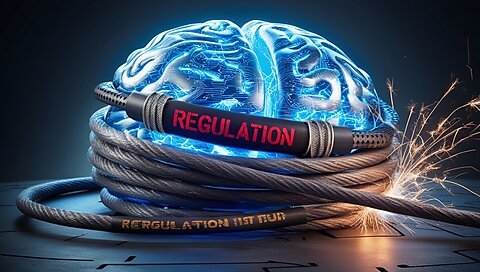Travis Fisher and Jennifer Huddleston
Artificial intelligence doesn’t run on optimism or buzzwords. It runs on electricity. This seems to be a growing concern as the technology advances, with outlets from Teen Vogue and Wired to the Washington Post and Harvard Business Review publishing articles about AI’s alarming energy and water consumption. The previous AI doomerism now seems to be focused less on AI’s application and more on its use of resources. However, there should be a case for optimism on both energy policy and technology policy regarding this issue.
Rather than immediately rushing to fit these growing energy demands into our existing policy frameworks, AI can provide an opportunity to rethink our static models and mental frameworks around energy. Such rethinking provides opportunities for dynamic growth in both technological innovation and energy. If the United States wants to lead the world in AI, policymakers must abandon the illusion that a centrally planned grid can power a decentralized technological revolution. Energy abundance and technological progress thrive when they are built on the same foundation: an open-ended market process with less government intervention.
Understanding AI’s Energy Demands and Society’s Accompanying Panic
AI is already reshaping electricity demand in ways the traditional system wasn’t designed to handle. After two decades of essentially no growth in electricity demand, US data centers could consume 6.7 to 12 percent of America’s electricity in just three years, up from 4.4 percent today. McKinsey estimates this surge will add about 460 terawatt-hours of demand between 2023 and 2030—roughly tripling current levels of electricity consumption by data centers. The scale and speed of data center growth highlight a fundamental mismatch: AI-driven demand is accelerating far faster than the legacy grid can accommodate.
But AI’s energy demands are far more complicated and part of a long-standing tradition of concerns about energy depletion in the face of new technologies. A 1999 Forbes headline, for example, discussed the need to “dig more coal, the PCs are coming” and noted the “electric load of a small village” the large servers needed. The original industrial revolution was met with The Coal Paradox and fears that the world’s coal supply would be exhausted.
But what actually happened in all of these cases? We found new sources of energy and improved our efficiency in the use of existing resources to power our growing and changing needs.
AI’s energy use is also more complicated than it may seem. For example, some of the significant elements of AI, like training a model, are one-time costs. In other cases, there are questions about what the alternative energy consumption would have been, such as doing repeated searches or longer processes that would also draw on energy resources. And as Daniel Castro’s report on the models that have predicted the demands and concerns of AI’s energy use shows, there is at least some reason to believe the current numbers might be inflated.
What AI Needs from the Energy Sector
Energy policy will be a needed element of our AI infrastructure if we want to continue to see this technology grow and flourish in many beneficial ways. The rapid pace of innovation means the AI revolution won’t wait for multi-year permitting fights, cost-of-service hearings held by regulators, or planning processes built for the analog era. And yet those are the structures that still govern electricity in much of the country.
Building a new transmission line in the US now takes about 10 years, while generation projects spend multiple years stuck in interconnection queues, with more than 2,600 gigawatts of capacity now in queues nationwide. America is trying to power a permission-less innovation boom in AI with an agonizingly slow, permission-first utility regime, and the results are predictably bad.
Market participants are already trying to solve the mismatch. Major firms are seeking direct power purchase agreements with independent generators, building behind-the-meter capacity, exploring private microgrids, and even considering small-scale nuclear partnerships when the technology matures. These efforts aren’t futurist gambits—they are attempts to work around today’s regulatory regime, which assumes electricity is something the government must gatekeep rather than something people can freely build and buy.
But unfortunately, many of these ideas can run up against existing regulatory barriers or significant requirements. (Ironically, in some cases, AI would be able to help with these requirements, such as reviewing environmental impact analysis or other paperwork steps to allow new solutions.) For policymakers who want to support unleashing American energy and innovation, the AI moment may provide a perfect opportunity for reform.
Tangible Policy Reforms
State policymakers have shown how simple reform can be. In August, New Hampshire enacted a one-page law that exempts off-grid electricity providers from public utility regulation. The logic is straightforward: if you’re not using or impacting the legacy grid, you shouldn’t have to ask legacy regulators for permission. We call this policy Consumer Regulated Electricity, or CRE. Similar reforms have already moved forward in Ohio, Utah, Oklahoma, and West Virginia.
That makes room for industrial-scale networks, development that is consumer-driven rather than regulator-approved, and tailored contracts between energy producers and large customers. Responsibility for any cost overruns stays with the parties involved, rather than being socialized across captive ratepayers.
It is an open question whether a new federal law could enact CRE nationwide in one fell swoop, but there are immediate steps federal policymakers could take to embrace the same hands-off approach. As one example, if a new industrial network is not connected to the existing bulk power system, grid reliability watchdogs at the Federal Energy Regulatory Commission (FERC) and the North American Electric Reliability Corporation should exempt it from the stringent rules that apply to the broader synchronized grid. This could be done by FERC through a rulemaking or by Congress through a simple definitional change in section 215 of the Federal Power Act.
Unlike burdensome top-down regulation focused on AI’s application, reforming energy policy can provide a way for policymakers at all levels to provide an infrastructure that could power AI innovation without dictating its applications or limits.
Why It Matters
In addition to practical policy issues, there is a philosophical debate beneath the surface. Progress does not come from central planning. It comes from exploration, the process of trial and error, and dynamic adaptation to changing circumstances. In a recent issue of Free Society, Johan Norberg argued that abundance tends to arise from unplanned, bottom-up problem-solving—not from central blueprints.
This year’s Nobel Prize in economics underscores the importance of innovation, knowledge systems, and openness to disruption. The laureates demonstrated how growth and long-run prosperity emerge when markets allow talent, ideas, and capital to move freely. Their research confirms what experience has already shown: we don’t get growth from planned economies. We get it by allowing discovery and competition, by embracing the open-ended market process. Regulations that restrict entry or stifle entrepreneurs may create stability in the short run, but they suffocate progress in the long run.
Energy and AI are no exceptions. In too many parts of the country, electricity policy is still built around forecasting demand, rationing supply, and approving projects through multi-year regulatory battles. AI and the industries emerging around it are growing quickly through trial and error, experimentation, and iteration. These worldviews were bound to collide. The notable exception is in the state of Texas, where the electricity system is dynamic and seems uniquely capable of accommodating the massive demand growth from data centers. But even the grid in Texas falls under heavy regulation and could benefit from Texas lawmakers adopting a true free-market approach like CRE.
Policymakers often claim they are acting out of caution when they slow or block new technology, but history tells a different story. The greatest risks come not from moving too quickly, but from freezing existing systems in place and assuming yesterday’s institutions can meet tomorrow’s needs. Overly cautious policies don’t signal a system preparing for the future; they signal that policymakers are afraid of it. Today’s obstructionism comes from local pushback on data centers and federal permitting regimes that stretch project timelines to a decade or more. Regulation is fast becoming the choke point not just for growth in energy use, but for growth in productive intelligence.
Conclusion
History shows that our fears of new technologies leading us to run out of energy are nothing new. Instead of further miring us in the status quo, AI could disrupt the way we approach energy policy. The ideas discussed above would allow policymakers to embrace the ways a free market can help meet AI’s electricity needs and unlock the broader economic transformation it represents.
In the sclerotic electricity sector, smart reform means a radical return to the American idea by legalizing alternatives to monopoly control, clearing government obstacles, and allowing price signals to guide investment. Intelligent power will not come from a permission-first system run by bureaucrats—it will come from the open-ended market process that runs on free enterprise and entrepreneurship.
Cato intern Ploy Sripungwiwat contributed to this article.
















